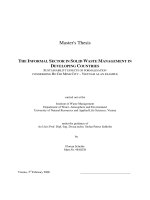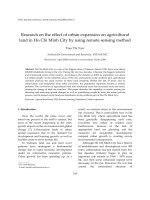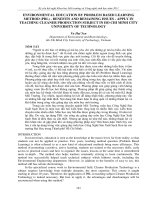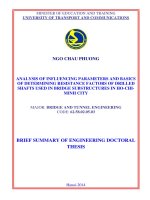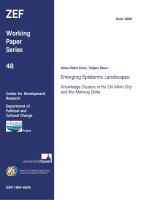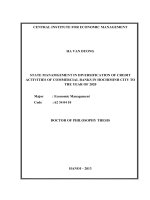Teachers beliefs and reported classroom practices in EFL writing instruction at the selected high schools in ho chi minh city a thesis submitted in partial fulfillment of the requirements for the degree of master of art
Bạn đang xem bản rút gọn của tài liệu. Xem và tải ngay bản đầy đủ của tài liệu tại đây (1.63 MB, 172 trang )
MINISTRY OF EDUCATION AND TRAINING
HO CHI MINH CITY OPEN UNIVERSITY
----------------------------------------------
TEACHERS’ BELIEFS AND REPORTED CLASSROOM
PRACTICES IN EFL WRITING INSTRUCTION AT THE
SELECTED HIGH SCHOOLS IN HO CHI MINH CITY
A thesis submitted in partial fulfillment of
the requirements for the degree of
Master of Arts (TESOL)
Submitted by TRUONG MINH HOA
Supervised by Assoc. Prof. Dr. PHAM VU PHI HO
Ho Chi Minh City, October 2016
STATEMENT OF AUTHORSHIP
I certify that this thesis entitled “Teachers’ Beliefs and Reported Classroom
Practices in EFL Writing Instruction at the Selected High Schools in Ho Chi
Minh City” is my own work.
Except where reference is made in the text of the thesis, this thesis contain material
published elsewhere or extracted in whole or in part from a thesis by which I have
qualified for or been awarded another degree or diploma.
No other person’s work has been used without due acknowledgement in the main text
of the thesis.
This thesis has not been submitted for the award of any degree or diploma in any other
tertiary institution.
Cam Ranh City, October 2016
Truong Minh Hoa
i
ACKNOWLEDGEMENTS
This Master of Art in TESOL thesis is the result of a fruitful collaboration of all the
people whom have kindly contributed with an enormous commitment and enthusiasm
in my research. Without the help of those who supported me at all times and in all
possible ways, it would not have been feasible for me to complete my M.A. thesis.
I would like to thank the Buddha and the Avalokiteśvara Bodhisattva, who made all
things possible.
I am deeply indebted to my supervisor, Assoc. Prof. Dr. Pham Vu Phi Ho, from Ho
Chi Minh City Open University, whose compassion, encouragement and guidance
throughout the research have helped in the completion of this thesis. I have truly
learned from the excellence of his skills and from his wide experience in research; no
words are adequate to describe the extent of my gratitude.
I would like to express my particular gratitude to my beloved mother Pham Thi Lien
and younger sister Truong Thi Phuong Hong Thao as well as my respectful teacher
Truong Viet Khanh Trang (Dean of Faculty of Garment Technology and Fashion, Ly
Tu Trong Technical College) for their unconditional love, understanding,
encouragement, financial and spiritual support over time and distance.
I would like to thank my TESOL classmates, including Nguyen Thi Thu Thuy, Phan
Thi Mien Thao, Mai Thi Ngoc Hanh, Luu Thi Huyen Tran, and Le Thi Minh Sang,
who shared their constructive opinions on my thesis.
I am also much obliged to the high school teachers, namely Vo Thi Bich Vien,
Nguyen Le Yen Thuy, Van Thanh Minh Trung, Tran Thi Hoang Trang, Nguyen Thi
Phuc Trinh, and Nguyen Thi My Chau, who enthusiastically helped me to distribute
and collect questionnaires as well as participated in my interview sessions.
I owe a great debt of gratitude to the anonymous participants who contributed data to
this thesis.
ii
ABSTRACT
Writing in a foreign language is deemed to be the most difficult language skill to learners,
especially at high school level; consequently, its teaching has become a challenging task for
the high school teachers in Vietnamese context. Teacher belief related literature indicates that
what teachers do in the classroom is directly governed by what they think and believe.
Thereby, the current study adopted features of a survey research design in order to examine
the EFL high school teachers’ beliefs about writing and its teaching, their actual classroom
practices, as well as the interplays between their beliefs and practices in the realm of EFL
writing instruction.
A sample of seventy–six EFL teachers from the eight selected high schools situated in Ho
Chi Minh City was recruited to the current survey. The beliefs and practices of EFL writing
instruction of these studied teachers were elicited through two instruments of thirty–nine–
item questionnaires and semi–structured interviews. Then the questionnaires were
quantitatively analyzed and the interviews were qualitatively analyzed.
Results of the study showed that most of the participants held different views/orientations
about writing skill and teaching writing, consisting of form–based, cognitive process–based,
functional social–based, and interactive social–based views; nevertheless, the form–based
orientation was still most favored in their beliefs. On the contrary, in practical, most of the
high school teachers much followed the product approach, which underlies form–based
orientation instead of different approaches. This can evidently account for the low results of
writing section in the National GCSE examination in consecutive recent years when high
school students only were asked to learn sample writing texts by rote (form–based
orientation) rather than being guided basic writing steps (process–based orientation) as well
as being developed their social awareness of what to be written (social–based orientation).
From the interviews, there was evidence to reveal that high school teachers’ ability to transfer
their beliefs into teaching practices was primarily impacted by schooling–related factors (e.g.,
class duration, curriculum, examination demands, teaching materials), and student–related
factors (e.g., students’ lack of motivation, students’ knowledge and language proficiency) as
well as teachers–related factors (e.g., teacher’ preparation time). Ultimately, some
implications of this study for high school teachers are also discussed.
iii
TABLE OF CONTENTS
Page
STATEMENT OF AUTHORSHIP ………………………………………………………………….i
ACKNOWLEDGEMENTS ………………………………………………………………………….ii
ABSTRACT …………………………………………………………………..……………………....iii
TABLE OF CONTENTS ……………………………………………………………………………iv
LIST OF TABLES ………………………………………………………………………………….viii
LIST OF FIGURES, CHARTS ………………………………………………………………………x
ABBREVIATIONS..…………………………………………..……………………………………...xi
Chapter One: INTRODUCTION
1.1 Background to the Study ........................................................................................................... 1
1.2 Rationale for the Study ………………………………………………………………………..5
1.3 Research Questions ……………………………………………………………………………7
1.4 Significance of the Study ………………………………………………………………………8
1.5 Key Words ……………………………………………………………………………………...9
1.6 Overview of the Thesis Chapters ……………………………………………………………..9
Chapter Two: LITERATURE REVIEW
2.1 Teaching Writing ...................................................................................................................... 11
2.1.1
Writing: Natures, Levels, and Aspects ………………………………………………….11
2.1.1.1 Natures of Writing ……………………………………………………………………11
2.1.1.2 Writing Levels ………………………………………………………………………..13
2.1.1.3 Aspects of Writing ………………………………………………………….………...14
2.1.2
Theoretical Orientations to Teaching Writing ………………………………………….15
2.1.2.1 Behaviorist Learning Theory……………………………………………....................16
2.1.2.2 Cognitive Learning Theory …………………………………………………………..16
2.1.2.3 Social Constructivism Learning Theory ……………………………………………...16
2.1.3
Approaches to Teaching Writing ……………………………………………………….17
2.1.3.1 Product Approach ……………………………………………………………………17
2.1.3.2 Process Approach ……………………………………………………………………18
2.1.3.3 Genre–based Approach ………………………………………………………………19
2.1.4
Roles of Writing Teacher ……………………………………………………………….21
2.1.4.1 Knowledge Transmitter………………………………………………………….……22
2.1.4.2 Facilitator…………………………………………………………………………….22
2.1.4.3 Feedback Provider …………………………………………………………………...24
2.2 Teacher Beliefs ………………………………………………………………………………..24
iv
2.2.1
Definition of Teacher Beliefs …………………………………………………………...24
2.2.2
Categories of Teacher Beliefs …………………………………………………………..25
2.2.2.1 Teachers’ Beliefs about the Subject Matter ………………………………………….26
2.2.2.2 Teachers’ Beliefs about Teacher Roles and Teaching ……………………………….28
2.2.2.3 Relationship between Beliefs about the Subject Matter, about Teacher Roles and
Teaching ……………………………………………………………………………...28
2.2.3
Importance of Teacher Beliefs on Practices of Teaching Writing ……………………...29
2.2.4
Factors Impacting Teacher Beliefs and Teachers’ Practices of Teaching Writing ……..30
2.3 Summary of English Writing Curriculum at Vietnamese High School …………………..31
2.3.1
English Textbooks for High School ……………………………………………………31
2.3.2
Objective of MOET towards Writing Skill at High School ……………………………32
2.3.3
Description of the Writing Sections ……………………………………………………33
2.4 Studies on Teachers’ Beliefs and Practices in Teaching Writing …………………………34
2.5 Research Gap …………………………………………………………………………………40
Chapter Three: METHODOLOGY
3.1 Pedagogical Settings and Participants ………………………………………………………42
3.1.1
Sampling Methods ……………………………………………………………………...42
3.1.2
Pedagogical Settings ……………………………………………………………………44
3.1.3
Participants ……………………………………………………………………………...45
3.2 Research Design and Process ………………………………………………………………..46
3.2.1
Research Design ………………………………………………………………………...46
3.2.2
Research Process ………………………………………………………………………..47
3.2.2.1 Pre–study Interviews …………………………………………………………………48
3.2.2.2 First Questionnaire Construct ……………………………………………………….51
3.2.2.3 Expert Comments on First Questionnaire ……………………………………………51
3.3 Research Instruments ………………………………………………………………………..54
3.3.1
Questionnaire for Teachers ……………………………………………………………..54
3.3.1.1 Rationale for Questionnaire …………………………………………………………54
3.3.1.2 Description of the Questionnaire ……………………………………………………55
3.3.2
Interview for Teachers ………………………………………………………………….58
3.3.2.1 Rationale for Interview ………………………………………………………………58
3.3.2.2 Description of the Interview …………………………………………………………59
3.4 Validity and Reliability ………………………………………………………………………60
3.4.1
Reliability ……………………………………………………………………………….60
3.4.2
Validity ………………………………………………………………………………….61
3.4.2.1 Content Validity ………………………………………………..………………….... 61
v
3.4.2.2 Construct Validity ……………………………………………………………………62
3.5 Data Collection ………………………………………………………………………………..63
3.5.1
Administering the Questionnaire ……………………………………………………….63
3.5.2
Conducting the Interview ……………………………………………………………….64
3.6 Data Analysis Procedure ……………………………………………………………………..66
3.6.1
Quantitative Analysis for Questionnaire ………………………………………………..66
3.6.2
Qualitative Analysis for Interview ……………………………………………………...66
Chapter Four: FINDINGS and DICUSSION
4.1 Research Question 1 …………………………………………………………………………68
4.1.1
Beliefs about Importance and Nature of Writing ………………………………………69
4.1.1.1 Beliefs about Importance of Writing …………………………………………………69
4.1.1.2 Beliefs about Nature of Writing ……………………………………………………...73
4.1.2
Beliefs about Teacher Roles and Teaching Writing ……………………………………78
4.1.2.1 Beliefs about Teacher Roles …………………………………………………………79
4.1.2.2 Beliefs about Teaching Writing ………………………………………………...……81
4.1.3
Summary of the Teachers’ Beliefs ……………………………………………………..87
4.1.3.1 Teachers’ Beliefs about the Importance of Writing to High School Students ……..…88
4.1.3.2 Teachers’ Beliefs about the Nature of Writing at High School Context ……..………88
4.1.3.3 Teachers’ Beliefs about Teacher Roles in Writing Classroom ………………………88
4.1.3.4 Teachers’ Beliefs about Teaching ……………………………………………………89
4.2 Research Question 2 ………………………………………………………………………….90
4.2.1
Pre–writing phase ………………………………………………………………………91
4.2.2
During–writing phase …………………………………………………………………..93
4.2.3
After–writing phase …………………………………………………………………….95
4.2.4
Summary of the Teachers’ Classroom Practices ………...……………………………..97
4.3 Research Question 3 ……………………………………………………………………….....98
4.3.1
Form–based Orientation: From Beliefs to Classroom Practices ………………………..99
4.3.2
Cognitive Process–based Orientation: From Beliefs to Classroom Practices ………...100
4.3.3
Functional Social–based Orientation: From Beliefs to Classroom Practices …………102
4.3.4
Interactive Social–based orientation: From Beliefs to Classroom Practices…………..104
4.3.5
Summary of the Interplays between the Teachers’ Beliefs and Practices …………….105
Chapter Five: CONCLUSION
5.1 Summary of Key Findings ………………………………………………………….………108
5.1.1
The Teachers’ Beliefs about Importance and Nature of Writing, Teacher Roles and
Teaching Orientations at High School Level ……………………………………….…108
vi
5.1.2
The Teachers’ Actual Classroom Practices of EFL Writing Instruction at High Schools
…………………………………………………………………………………………110
5.1.3
The Extent of Congruence between the Teachers’ Beliefs and Classroom Practices…111
5.2 Implications of the Findings ………………………………………………………..………112
5.3 Limitations of the Study ……………………………………………………………….……114
5.4 Recommendations for Further Research …………………………………………….……115
5.5 Contributions of the Study …………………………………………………………………116
REFERENCES …………………………………………………………………………………..117
APPENDICES …………………………………………………………………………………...125
vii
LIST OF TABLES
Page
Chapter Two: LITERATURE REVIEW
Table 2.1: Teacher Roles Proposed by Uddin (2014) …………………………………….. 23
Table 2.2: Teacher Beliefs Suggested by Some Authors …………………………………. 25
Table 2.3a: Examples of Teachers’ Beliefs about Subject Matters ………………………..26
Table 2.3b: Teachers’ Beliefs about Nature of Writing Skill ……………………………... 27
Table 2.4: Objective of MOET (2006) toward Writing Skill at High School ………..…… 32
Table 2.5: Text Types of Writing Sections ……………………………………..………… 33
Chapter Three: METHODOLOGY
Table 3.1: The Pedagogical Settings ……………………………………..……………….. 44
Table 3.2: Demographical Information of Participants ……………..…………………….. 45
Table 3.3a: Results of Pre–study Interview 1…………………..………………………….. 48
Table 3.3b: Results of Pre–study Interview 2 …………..…………………………………. 50
Table 3.4: Profiles of Participants in the Pilot Study………………………………...…….. 52
Table 3.5: The Link between Research Questions and Instruments ……….….………….. 54
Table 3.6: Description of the Questionnaire (Part II) ……………………..……………..... 56
Table 3.7: Description of the Questionnaire (Part III) ………………..…………………… 57
Table 3.8: Reliability Analysis (Cronbach’s Alpha) ……………..………………...….….. 60
Table 3.9: Process of Questionnaire Delivery and Collection ...………………….…...….. 63
Table 3.10: Demographical Information of the Interviewees..………………….………… 65
Chapter Four: FINDINGS and DISCUSSION
Table 4.1: Teachers’ Beliefs about the Extent of Importance of Writing …………………69
viii
Table 4.2: Teachers’ Beliefs about Reasons for Importance of Writing ……….…….…71
Table 4.3: Teachers’ Beliefs about Nature of Writing ………………………….…...…. 74
Table 4.4: Teachers’ Beliefs about Teacher Roles …………………………..…………. 79
Table 4.5: Teachers’ Beliefs about Teaching Writing …………….…………….……… 82
Table 4.6: Teachers’ Classroom Practices on Pre–writing Activities ……………….…...91
Table 4.7: Teachers’ Classroom Practices on While–writing Activities ….……………. 93
Table 4.8: Teachers’ Classroom Practices on After–writing Activities…..………….….. 95
Table 4.9a: A Comparison between the Teachers’ Beliefs and Practices ……..…………99
Table 4.9b: A Comparison between the Teachers’ Beliefs and Practices …..……….… 100
Table 4.9c: A Comparison between the Teachers’ Beliefs and Practices ...……...…..… 102
Table 4.9d: A Comparison between the Teachers’ Beliefs and Practices……………..... 104
ix
LIST OF FIGURES, CHARTS
Page
Chapter Two: LITERATURE REVIEW
Figure 2.1: Borg’s (2003) Framework …………………………………………………… 30
Chapter Three: METHODOLOGY
Figure 3.1: Research Process …………………………………………………………….. 47
Chapter Four: FINDINGS and DISCUSSION
Chart 4.1: Impacting Factors on Interplays between Teachers’ Beliefs and Practices …. 106
x
ABBREVIATIONS
EFL: English as Foreign Language
ELT: English Language Teaching
GCSE: General Certificate for Secondary Education
MOET: Ministry of Education and Training
TESOL: Teaching English for Speakers of Other Languages
xi
Chapter One
INTRODUCTION
1.1 Background to the study
In learning a foreign language, learners are subjected to four skills in a natural order
of acquisition that are listening, speaking, reading, and writing. And the latter, writing, is
deemed to be the most difficult language skill to be acquired (Mekki, 2012), requiring
“the mastery of a variety of linguistic, cognitive, and sociocultural competencies”
(Barkaoui, 2007). As what Mekki (2012) asserts, writing is a “difficult, sophisticated,
social activity and an important skill for language learners as well as native speakers”.
For linguistic factors, writing imposes a great necessity for careful and precise
completion, organization and connection of sentences. For cognitive factors, sometimes
the task of writing is imposed on us and this may cause a loss of ideas. For the
psychological factors, there is a lack of interaction and feedback between the writer and
the reader, the thing which makes writing a difficult task.
According to Mekki (2012), one of primary causes making writing skill difficult to
acquire is that students or teachers still believe that students‟ good writing ability derives
from what they have learnt about language and text forms but ignore specific steps and
collaborative strategies. It can be inferred that in order to master writing skill, language
learners not only need linguistic knowledge since “even with linguistic knowledge
students often struggle to produce a cohesive piece of writing” (Uddin, 2014), but they
also grasp their social awareness of writing contexts (Khanalizadeh & Allami, 2012) as
well as their cognitive awareness of the processes they use to write (Hyland, 2003).
In helping learners develop their writing which is deemed such a sophisticated skill, it
is evidenced that “teachers are one of the key factors in delivering instruction that leads
to the development of competent literacy learners, [...] to be pivotal in influencing
students‟ literacy achievement” (Kraayenoord et. al, 2009). In other words, what teachers
1
teach may have explicit effects on writing performance of their students (Nguyen Ho
Hoang Thuy, 2009).
As teachers play such a critical role in developing learners‟ writing performance, their
instructional beliefs have also become a key issue in education since “what they believe
as well as what they do not believe have powerful influence on their classroom
behaviors” (Le Van Canh, 2011). This may originate from the view that “teachers are
active, thinking decision–makers who make instructional choices by drawing on complex
practically–oriented, personalized, and context–sensitive networks of knowledge,
thoughts, and beliefs” (Borg, 2003). In specific, Kuzborska (2011) elaborates that
“teachers‟ beliefs influence their goals, procedures, materials, classroom interaction
patterns, their roles, their students, and the schools they work in”. Therefore, Richards et
al. (2001) posit that “in order to understand how teachers approach their work, it is
necessary to understand the beliefs and principles they operate from”.
Indeed, teachers‟ beliefs in language education have been receiving an increased
concern from educational researchers and extensively discussed in literature (e.g., Farrell
& Particia, 2005; Yin, 2006; Phipps & Borg, 2009; Khonamri & Salimi, 2010;
Kuzborska, 2011; Li, 2012; Regassa & Teshome, 2015) since the 1970s (Zheng, 2009;
Erkmen, 2014), significantly contributing to the exploration of teachers‟ beliefs, and the
relationship between teachers‟ beliefs and practices (Zheng, 2009; Shinde & Karekatti,
2012). To put it different, exploration of teachers‟ pedagogical beliefs is at the heart of
our understanding of their planning, instructional decisions, and classroom practices. For
example, Li (2012) emphasizes that “a teacher‟s educational beliefs in the language
teaching–learning process will exert an imperceptible influence on forming active
language teaching methods and will bring about an improvement in students‟ language
abilities”.
Specific to the field of writing instruction, in recent years, researchers have shown an
increased interest in exploring how teachers think, feel and perceive about nature of
2
writing, their teacher roles and teaching in classroom, as well as the congruence between
what they believe and what they actually do in writing instruction (e.g., Farrell, 2006;
Khanalizadeh & Allami, 2012; Abadi & Marzban, 2012; Melketo, 2012; Corpuz, 2011;
Uddin, 2014; Nigam, 2015; Gaitas & Martins, 2015).
Farrell (2006) posits that “teachers examine their values and beliefs about teaching
and learning so that they can take more responsibility for their classroom actions”.
Empirically, the study showed that the participant believed that writing was an
intellectual activity which takes a lot of time for thinking and analyzing; therefore, the
participant took process approach to teaching writing. It is found that teachers‟ beliefs
have a direct effect on the teaching practices by transferring those beliefs into a practical
reality. In the similar vein, teachers‟ beliefs about nature of writing and teaching writing
skill have also been found in Khanalizadeh & Allami (2012). The study heightened
teachers‟ beliefs about theoretical orientations to writing including (1) writing as a formal
system, (2) as a cognitive process, and (3) as a social activity. More systematically,
English teachers‟ beliefs on the teaching of writing for both primary and high school
students were also investigated in Abadi & Marzban (2012) according to four main
categories, comprising of (1) meaning of writing; (2) importance of writing; (3) teaching
activities and practices; (4) feedback. In term of age factor, differences in teaching
writing skill should exist when we teach for different groups of students.
Not only teachers‟ beliefs about writing and teaching writing have constantly been
explored, but relationships between teachers‟ beliefs and their actual classroom practices
of writing instruction have also been published (e.g., Melketo, 2012; Uddin, 2014;
Nigam, 2015). For examples, Uddin‟s (2014) study has yielded its findings that although
the participants believed that writing as a process and student writers should follow
several stages to write such as gathering idea, planning, revising, drafting, they were
unable to practice in classrooms what they believed for some reasons including large
classroom, exam oriented culture, demands of syllabus completion on time, low–level
students, and time constraints. Likewise, Nigam (2015) examined how beliefs impact
3
classroom writing instruction at Auburn Elementary School in the United States. As what
have been reported in this case, the teacher believed students needed understanding of the
components of the process (e.g., brainstorming, planning, rough draft, final draft) which
she modeled in her instruction. Evidently, the participant highly employed process–
orientation to teaching writing in her classroom. Still, she admitted that in practical,
beliefs were not always aligned with writing instruction for some causes such as demands
of assessment, professional development availability, challenges of the classroom
context, and level of preparation for teaching writing. Additionally, in Gaitas & Martins
(2015), both form and content of writing were highly believed by the primary teachers;
then these beliefs were consistently transferred into classroom organization that the
participants organized writing activities in various configurations such as solo, pair or
small group. Clearly, the relationship between teachers‟ beliefs and their practices has
been open to debate up to now, which is often impacted by multiple factors.
Language teachers‟ beliefs and the interplay between teachers‟ beliefs and their actual
practices have been extensively studied for different purposes. Khanalizadeh & Allami
(2012) sees that “the study of teachers‟ belief about teaching, learning, learners, and the
influence it may have on teaching practices, activities, and learning outcomes” should be
considered “to find effective teaching behaviors”, and “to assist teachers become
effective professionals and increase students‟ achievement in core subject areas”
(Melketo, 2012). Likewise, examining the links between personal theories, practices will
“help clarify how teachers change their approaches to teaching and learning over time”
(Richards et al., 2001). With a broader aim, the exploration of teachers‟ beliefs and
practices has “a huge impact on the work of curriculum reformers, policy makers and
other educational supervisors and leaders” (Msendekwa, 2015).
4
1.2 Rationale for the study
Very recently, since the academic year of 2013–2014, free writing a paragraph in
response to a given topic has been called for the English paper of the National GCSE
examination in Vietnamese context. Ironically, the results of these papers mainly went
around between 2.0 to 3.5 points. Essentially, these unexpected results originate from the
fact that a large number of high school candidates either did not know how to construct
the text or skipped their writing section, which holds twenty percent of the whole English
paper (TuoitreOnline, 2015).
Surprisingly, this problem also occurred in this academic year of 2015–2016.
According to what Vietnamnet (2016) has reported, many candidates of 2016 National
GCSE examination in Ho Chi Minh city either did not complete their writing section in
time or skipped it. Some students revealed that they found writing section really difficult.
In addition, others admitted that because of learning some sample texts which were
provided by their teachers by rote, when the topic in the writing section had a little
change, they could not manage it. It is interpreted that most high school students do not
know how to do free writing, and they do not handle the strategies for composing texts
independently but actually practice writing in a controlled way. This is like what
Khanalizadeh & Allami (2012) described about teaching–learning writing in Iran,
“writing skill is often limited to making sentences, and the grammatical points of those
sentences are the most important parts of learning how to write”. To add more, Tran
(2007) raised her voice that writing skill has been conducted in the classroom in Vietnam
as “an individual activity with the teacher as the sole audience, and the students are quite
quiet”. It means there is a lack of interaction among students in writing classroom.
Such low results of writing section in National GCSE examination in consecutive
recent years have evidently proved that writing is a “difficult, sophisticated, social
activity and an important skill for language learners” (Mekki, 2012), requiring “the
mastery of a variety of linguistic, cognitive, and sociocultural competencies” (Barkaoui,
5
2007). Alternatively saying, being capable of writing well, it requires more than linguistic
knowledge and memory of sample texts (i.e., form–based view); it also needs learner
writers know how to construct their texts independently (i.e., cognitive process–based
view) and an active interaction with other writers in learning process (i.e., social–based
view). As a matter of fact, having high school students imitate and memorize the sample
texts might only have its temporary effect on examinations to some extent.
The aforementioned alarming situation has raised some questions such as whether
writing skill is “truly perceived” and “equally treated” as other language skills in high
school context; and whether teaching activities and teacher roles performed in writing
classroom are genuinely useful to help high school students develop their own writing
ability. Thereby, investigating how high school teachers help their students learn and
develop their writing skill in practical should be also taken into consideration. Indeed, the
researcher found it crucial since understanding of teachers‟ actual classroom practices
could partly explain for such low results of writing section in the National GCSE
examination in successive recent years. Repeatedly, this necessity stems from “teachers
are one of the key factors in delivering instruction that leads to the development of
competent literacy learners” (Kraayenoord et. al, 2009).
As what Khanalizadeh & Allami (2012) said, students‟ low writing performance and
that writing is the least developed language skill “could be partly due to the effect of the
teachers‟ beliefs about writing and its teaching”. Accordingly, “teachers‟ beliefs are
important concepts in understanding teachers‟ thought processes, instructional practices”
(Zheng, 2009). On the other hand, in Vietnam, exploration of language teachers‟ beliefs
as well as the relationship between teachers‟ beliefs and practices in language education
seems scanty and little concerned (Le Van Canh, 2011). Thereby, it was necessarily
important for the researcher to explore high school teachers‟ beliefs about the importance
of writing skill; how they perceive about the nature of writing; how these teachers
understand about their teacher roles and teaching orientations in writing instruction at
high school context.
6
A considerable amount of literature indicates that the teachers‟ practices in the
classroom are affected by their beliefs (Regassa & Teshome, 2015). However, while
some researchers reported a high degree of congruence between teacher beliefs and their
practice of teaching, others have identified incongruence between teacher belief and what
actually they do in classroom. Put simply, “teachers have a set of belief systems that are
sometimes not reflected in their classroom practices for various complicated reasons”
(Khader, 2012). Because of this, the researcher made an attempt to examine whether what
high school teachers actually do should be governed by their belief systems. If this
relationship between beliefs and classroom practices is incongruent to some extent, then
several attempts would have been made to seek which factors may affect connection
between teachers‟ pedagogical beliefs and their classroom practices of teaching writing
skill in high school context.
In sum, the purpose of the study was to work out the answer to the question of what
beliefs the selected high school teachers in Ho Chi Minh City hold about the importance
and nature of writing, as well as about their roles and orientations to teaching writing for
high school level. Besides, the study aimed to explore what actual classroom activities of
teaching writing the recruited teachers frequently conduct in their writing class. Finally,
the survey pursued to investigate whether there are any differences between the teachers‟
stated beliefs and their actual classroom practices in teaching writing for their high school
students, and then some impacting factors on this interplay were consequently sought.
1.3 Research questions
In order to fulfill the purpose stated above, three research questions were addressed as
follows:
R–Q 1: What beliefs do the teachers at selected high schools hold in terms of (1)
importance and nature of writing; (2) teacher roles and teaching process?
7
R–Q 2: What teaching practices in writing classrooms do the teachers at selected high
schools report?
R–Q 3: Are there any differences between the teachers‟ stated beliefs and their
reported classroom practices in teaching writing? If yes, what factors impact the teachers‟
transfer of their beliefs into writing teaching practices?
1.4 Significance of the study
As mentioned earlier, students in many Vietnamese high schools in common and in
Ho Chi Minh City high schools in particular have not learned EFL writing skill in its own
right. In specific, these students normally imitate and memorize the sample texts, which
might only have its temporary effect on examinations if any, but have not known how to
construct their own writing texts independently and meaningfully so far. With the hope of
enabling the high school students to manage their writing performance by themselves
(i.e., process–based orientation) and in a meaningful way (i.e., social–based orientation)
rather than only possess separate linguistic knowledge (form–based orientation), the
researcher was inspired to conduct this survey. Some significance of the study was found
out as following:
The first significance: There are no many studies on the high school teachers‟ beliefs
about writing and its teaching in Vietnam context. In other words, research done in the
realm of teachers‟ belief system of teaching writing and classroom practices at high
school level appears in the country to be scanty. In particular, almost no studies examine
the high school teachers‟ perceptions of writing nature and teaching orientations so–
called systematically in accordance to different form–based, social–based, cognitive
process–based perspectives.
The second significance: The exploration of the high school teachers‟ beliefs and
their actual classroom practices plays a pivotal role in helping these teachers modify their
current teaching behaviors so that the teachers may increase students‟ stable achievement
in EFL writing skill, which deems to be equally important to other language skills in
8
language acquisition at any degree. In means that writing skill at high schools must be
developed via such a learner–centered environment in which (1) students are provided
necessary language input (form–based view); (2) students have opportunity for their
independent writing (cognitive process–based view); (3) students capture the context and
purpose of what to be written (functional social–based view); (4) students participate in
collaborative activities (interactive social–based view).
1.5 Key words
While a variety of definitions of the two terms “teachers‟ beliefs” and “classroom
practices”, this paper will use the definitions suggested by Richards (1998) and Khader
(2012).
Teacher beliefs: The information, attitudes, values, expectations, theories, and
assumptions about teaching and learning that teachers build up over time and bring with
them to the classroom (Richards, 1998), which influence their classroom practices
(Khader, 2012).
Classroom practices: A set of teaching strategies and methods of instruction
employed in the classroom (Khader, 2012).
1.6 Overview of the Thesis Chapters
The current chapter, Introduction, presents the general interest of the study, the
research purpose, research questions and significance of the study.
As the name suggests, in chapter two, Literature Review, the theoretical background
to this research is provided by reviewing the areas of interest to the study. Foremost, it
looks at the general background related to writing and its teaching. Following that,
teacher belief systems in connection to nature of writing and its teaching will be
discussed, consisting of definition, categories, importance and impacting factors between
the connections between teachers‟ beliefs and their actual classroom actions. Most
importantly, the chapter moves on to summarize some related empirical studies which
9
examined the relationships between teachers‟ belief systems and classroom practices in
the realm of teaching writing. Based on what have already been done with regard to the
study‟s field, some research gaps are provided to situate the study itself.
The design and method of this study are presented in chapter three, Methodology. In
specific, this chapter will present the context and population, data collection methods and
how they were designed and developed, in addition to other methodological concerns
such as the reliability and validity as well as ethical issues of the research area. Also, it
describes how the data were collected and which tools were used in the analysis process,
and how the data were presented.
Chapter 4, Findings and Discussion, provides a comprehensive presentation and
discussion of the results of the study obtained from the analyses of questionnaires and
interviews.
As the name suggests, in Chapter 5, Conclusion, the main findings of the study will be
precisely summarized. Some contributions of this work are then presented in this chapter.
Besides, the last chapter of this work reveals the limitations and offers suggestions for
further research.
10
Chapter Two
LITERATURE REVIEW
The aim of this chapter is to present the theoretical background used to underpin this
study, highlighting nature of writing and its teaching approaches, as well as teachers‟
belief systems which directly or indirectly affect teachers‟ instructional practices in
teaching writing. The chapter is divided into five main parts. The first part (2.1) looks at
the general background related to writing and its teaching, including nature, levels and
aspects of writing; theoretical orientations and approaches to teaching writing; writing
teacher roles. The second part (2.2) deals with teacher belief systems in connection to
nature of writing and its teaching. This part provides definition, categories, importance
and impacting factors between the connections between teachers‟ beliefs and their actual
classroom actions. The third part (2.3) summarizes English writing curriculum at
Vietnamese high school. Following this, the chapter moves on to review some related
empirical studies which have examined the relationships between teachers‟ belief systems
and classroom practices so far in the realm of teaching writing, in the fourth part (2.4).
Based on what have already been done with regard to the study‟s field, the fifth part (2.5)
draws out some research gaps which make the researcher attempt to occupy in the
existing body of literature and situate itself.
2.1 Teaching Writing
In this section, the general background related to nature of writing and its teaching
will be reviewed, consisting of (1) natures, levels, aspects of writing; (2) theoretical
orientations to teaching writing; (3) teaching approaches; (4) writing teacher‟s roles.
2.1.1 Writing: Natures, Levels and Aspects
2.1.1.1 Natures of Writing
The natures of writing are variously described by some experts.
11
From a linguistic perspective, Harmer (2004) believes that writing encourages
students to focus on accurate language use. In other words, linguistic accuracy (e.g.,
vocabulary or grammar, linkers) is the main concern of writing act.
Conversely, in Grami‟s (2010) work, the author reviews some other researchers‟
works, describing writing as a complicated cognitive activity. Then he explains writing as
complex cognitive act because it “demands careful thought, discipline, and concentration,
and it is not just a simple direct production of what the brain knows or can do at a
particular moment”. To illustrate, Graham (1997, in Nguyen Thanh Huy, 2015) points out
key components in writing process: (1) knowledge of writing and writing topics, (2) skill
for producing text, (3) processes for motivating participants to write with enthusiasm, and
(4) directing thought and actions through strategies to achieve specific writing goals.
In another point, Hyland (2003) emphasizes writing as a social activity which
“expressing a culturally recognized purpose, reflecting particular kind of relationship and
acknowledging an engagement in a given community” and “through using language
called genres”. In addition, the author provides another aspect of what is called “social
activity” by “writing is a purposeful and communicative activity that responds to other
people and other texts”. In this circumstance, teacher and peer feedback is mentioned as
an important role in students‟ writing development.
Based upon the natures of writing undergone by different perspectives in the existing
body of literature, the researcher can draw out some potential writing natures such as
Writing is a form–focused or linguistic accuracy–based activity;
Writing is a cognitive activity adhered to steps of a writing process;
Writing is a social activity within specific writing goals;
Writing is a social activity in term of interaction among writer and readers.
12
2.1.1.2 Writing levels
Learners usually learn and practice “the art of putting words together” (Harmer, 2004)
according to two levels: sentential level (between one to two sentences) and textual
level (paragraphs or text genres).
Writing at sentential level
Harmer (2004) states that the kind of writing at sentential level is often used for
“grammar reinforcement”; later, he exemplifies that “students are given one or two model
sentences and then have to write similar sentences based on information they are given”.
In more academic fashion, Dikilitaş (2012) describes the sentential level as “grammatical
features of syntax at surface level representing semantics at deep structure”.
Referring to the reality of teaching English at high school, writing at sentential level
often occurs in grammar classes (E. Language Focus). In these classes, sentence writing
mostly deals with accuracy of grammatical structures through students‟ doing some
exercises such as transformation, matching, arrangement, etc. Seemingly, writing at this
level in Vietnamese high schools focuses mostly learning grammar rather than learning to
write English as a skill in its own right. Thus, the study merely aims to the teaching of
writing English at textual level (D. Writing section), that is, paragraph or text genres.
Writing at textual level
On the textual level of writing, Dikilitaş (2012) reveals it is „functional features of
cohesion at surface level leading to coherence at deep structure‟. In other words, beyond
the sentence, the writers will have to organize their ideas into cohesive and coherent
paragraphs and texts. Regarding writing at textual level, since writing is a means of
communication, “fulfils a set of communicative needs, and accomplishes particular
purpose” (Hyland, 2003), texts underlie different genres, or text types.
In “D. Writing” sections of Tieng Anh 10, Tieng Anh 11 and Tieng Anh 12, the
coursebook series used to teach English subject at high school, students are exposed to
13
